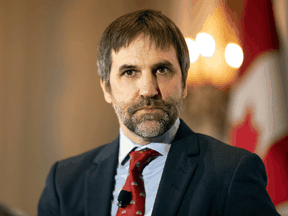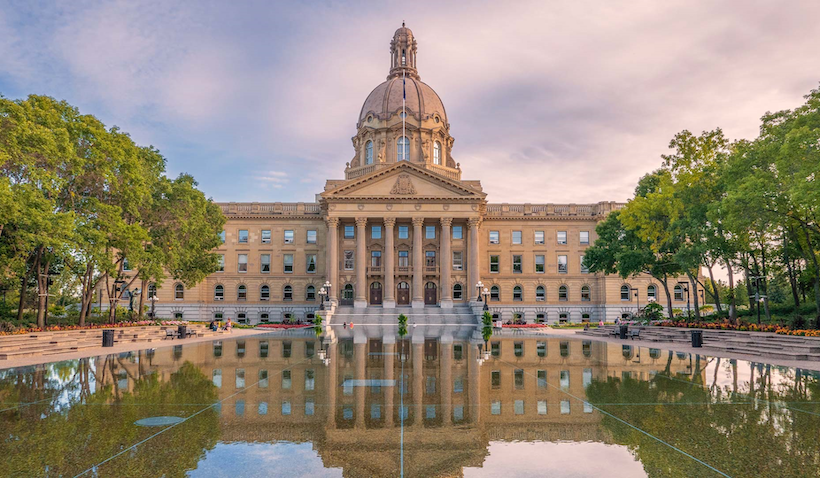The Alberta government is vowing to “chart its own path” in reaction to the federal government’s proposed Clean Electricity Regulations (CER) for industry that were released early Thursday, with Premier Danielle Smith calling the draft rules “unconstitutional and irresponsible.”
The regulations are intended to create a Canada-wide net-zero power grid by 2035, with incentives for provinces tied to meeting that goal spelled out in a policy document released earlier in the week.
Hours after the plan was unveiled by federal Environment Minister Steven Guilbeault in Toronto, Smith issued a statement claiming the regulations would jeopardize the reliability of the province’s power grid and lead to rising electricity costs.
“They will not be implemented in our province — period,” her statement reads.
She added that if the province can’t find common ground with Ottawa, “Alberta will chart its own path to ensuring we have additional reliable and affordable electricity brought onto our power grid that is available 24 hours a day, 365 days a year.”
Smith touted her government’s plan to craft “a reliable and affordable carbon-neutral grid by 2050.”
“This is the direction Alberta is going. We invite the federal government to support us, rather than hinder us, in doing so.”
New Brunswick, Nova Scotia, Manitoba, and Saskatchewan have all also said achieving Ottawa’s 2035 target will not be possible.
The regulations are not yet finalized pending the results of a 75-day consultation period with final regulations expected to be ready sometime next year.
The premier’s statement makes no mention of the Alberta Sovereignty Within a United Canada Act which was designed to counter federal laws the province believes to be unconstitutional, nor does it explain what about the proposed regulations makes them unlawful.

Speaking to reporters later Thursday, Environment Minister Rebecca Schulz cited restrictions to future natural gas development as cause for constitutional concern.
“That is absolutely an area of provincial jurisdiction,” she said, adding the sovereignty act was a tool but “ideally not something we’d have to use.”
She said she was disappointed feedback from previous meetings with Guilbeault was apparently not incorporated in remarks that came days after she referred to Ottawa’s green grid plan as a “threat” to Alberta.
‘Rules of the game’
As currently written, the draft regulations allow for some use of fossil fuels, including natural gas, to generate power at peak demand times or as a backup to non-emitting power sources.
“What we’re talking about is not a fossil fuel-free grid by 2035. It’s a net zero grid by 2035,” Guilbeault told reporters Thursday.
“We understand there will be some fossil fuels remaining … but we’re working to minimize those, and the fossil fuels that will be used post-2035 will have to comply with rigorous environmental and emission standards.”
Natural gas plants that are operating now would have to phase out over 20 years, according to the regulations.
The Canadian Association of Petroleum Producers was more skeptical, issuing a statement expressing concern about the use of natural gas as a backup to renewable energy post-2035, adding it intends to take part in the consultation process.
“Canada produces some of the world’s lowest-emitting natural gas and is a critical part of our country’s energy security, including acting as a backup for the intermittency challenges of renewable power,” the association stated.
“We are also concerned that the proposal will have investment impacts, causing further uncertainty in the Canadian energy sector.”
The regulations are set to take effect on Jan. 1, 2035, with Guilbeault saying they follow “hundreds” of consultations with experts, utilities, provinces, and environmental organization experts.
“The reason we’re announcing this 12 years ahead of this deadline is to give investors, utilities, public or private, provinces, territories the lead time to do the necessary investment and build out the grid so that by 2035 our grid is carbon neutral,” he said.
That included a July trip to Calgary to meet with industry groups, who Guilbeault said were anxious to know the regulations.
“And, that’s exactly what we’re doing. We’re giving them a lot of time to prepare.”

Guilbeault said that government modelling indicates more than $400 billion in investments is needed on the part of provinces, territories and utilities “to ensure that the grid will respond to growing demands for electricity” spurred by an increasing population and growing numbers of electric heating and cooling systems as well as electric vehicles.
His department estimates Canadians will spend 12 per cent less on clean electricity costs compared to home heating oil and gas.
Pricey power problems
Electricity has emerged as major political issue in Alberta over the summer months, with analysts forecasting power demand could double between now and 2050.
Alberta’s regulated rate option rate (RRO) rose to a new record high last month, days after the province pledged to overhaul the default rate. Customers who choose to remain on the RRO, or are unable to sign up for a fixed contract, will have to pay back in the coming months a $200-million government loan to utility companies made as part of the province’s affordability plan.
Earlier this month, the province announced a more than six-month moratorium on approvals for new, large-scale renewable energy projects, citing rural and environmental concerns. The pause drew criticism for being “anti-business” as well as for potentially scaring off business and being inconsistent with how the government treats the oil and gas industry.
As drafted, the regulations would remove more than 340 megatonnes of greenhouse gasses between 2024 and 2050.
Currently, more than 84 per cent of electricity in Canadian power grids is generated from non-emitting sources like hydro, nuclear and wind.



